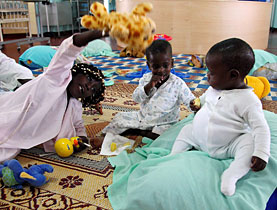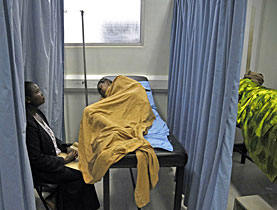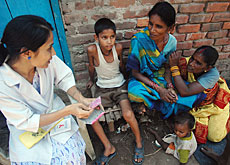Global Aids attention turns to Latin America

Preventing the spread of HIV/Aids is the central theme of the 17th International Aids Conference (Aids 2008), which has opened in Mexico City.
A Swiss delegation is attending the five-day meeting, the first of its kind in Latin America, which is expected to draw around 25,000 participants from across the globe, including many world-renowned leaders and experts.
Aids 2008 was officially opened on Sunday by Mexican President Felipe Calderón Hinojosa. Other opening session speakers include Secretary-General of the United Nations Ban Ki-moon, Director-General of the World Health Organization Margaret Chan and Executive Director of the Joint United Nations Programme on HIV/Aids Peter Piot.
The International Aids Conference takes place every two years and is the biggest such meeting anywhere in the world. This year’s theme of “Universal Action Now” stresses the need for continued urgency in the worldwide response to HIV/Aids and for action on the part of all stakeholders.
Among the 60-strong Swiss delegation are three representatives from the Federal Health Office and experts from various organisations and universities.
The health office said it hoped to hear new developments and to exchange experiences and ideas. The main themes for Switzerland are prevention, improvements in therapeutic treatement, human rights and solidarity.
Thomas Zeltner, director of the Federal Health Office, told swissinfo in June that although progress was being made in the fight against HIV/Aids, targets for 2010 set in 2001 would not be reached and that more work was needed regarding prevention.
British singer Annie Lennox, who will attend the conference as an ambassador for British charity Oxfam, warned that complacency threatened to slow the fight against Aids and urged artists, musicians, filmmakers and women to keep the issue at the forefront.
“This dialogue must not go off the table,” she said on Saturday, adding that 1,000 South Africans die of Aids every day and millions remain without access to health care.
Sub-Saharan plight
UNAIDS figures released in advance of the conference revealed that global deaths from Aids reached an estimated two million in 2007, down from 2.1 million deaths in 2006.
The Aids virus infects 33 million people globally, with Sub-Saharan Africa remaining the region most heavily affected by HIV, accounting for two thirds of all people living with HIV and 75 per cent of Aids deaths in 2007.
An estimated 1.9 million people were newly infected with HIV in sub-Saharan Africa in 2007, bringing to 22 million the number of Africans living with HIV.
New HIV infections in Latin America and the Caribbean in 2007 totalled an estimated 140,000, bringing to 1.7 million the number of people infected with the Aids virus in this region. An estimated 63,000 Latin Americans died of Aids last year. The overall levels of HIV infections in Latin America have changed little in the past decade.
Across South America, levels of HIV infection among female sex workers have tended to be much lower than those among men who have sex with men. HIV transmission as a result of injecting drug use still features in several of South America’s epidemics.
US commitment
On Saturday health officials in the United States reported that the number of Americans infected by the Aids virus each year was much higher than the government has been estimating, acknowledging that their numbers have understated the level of the epidemic.
The US had roughly 56,300 new HIV infections in 2006 – a dramatic increase from the 40,000 annual estimate used for the last dozen years. The new figure is due to a better blood test and new statistical methods, and not a worsening of the epidemic, officials said.
The revised estimate by the Centers for Disease Control and Prevention (CDC) and the methodology behind it were to be presented in Mexico on Sunday.
Some experts celebrated that finding, saying it was a tribute to prevention efforts, including nearly 200 syringe exchange programmes now operating in 36 states despite a federal ban on funding for such projects.
But they also lamented the CDC’s finding that infections continue to increase in gay and bisexual men, who accounted for more than half of HIV infections in 2006. Also, more than a third of those with HIV are younger than 30.
Some advocates say that suggests a need for more prevention efforts, particularly targeting younger gay and bisexual men.
Last week President Bush signed a $48 billion (SFr50.3 billion) global Aids bill to continue a programme that he called “the largest commitment by any nation to combat a single disease in human history”.
swissinfo with agencies
According to the Federal Health Office, nearly 30,000 men and women in Switzerland tested positive for HIV between 1985 and 2006.
Estimated number of new infections per year: 750-800.
The number of new infections increased significantly among homosexual men between 2004 and 2006, but dropped among other groups.
Between 1983 and 2006, 8,418 people were diagnosed with Aids, of whom 235 died in 2005 and 165 in 2006.
To date, 5,671 people have died of Aids in Switzerland.
To reduce by 2005 HIV prevalence among young men and women aged 15 to 24 in the most affected countries by 25 per cent and by 25 per cent globally by 2010.
By 2005, ensure that at least 90 per cent, and by 2010 at least 95 per cent, of young men and women aged 15 to 24 have access to the information, education, including peer education and youth-specific HIV education, and services necessary to develop the life skills required to reduce their vulnerability to HIV infection, in full partnership with young persons, parents, families, educators and health-care providers.
By 2005, reduce the proportion of infants infected with HIV by 20 per cent, and by 50 per cent by 2010, by ensuring that 80 per cent of pregnant women accessing antenatal care have information, counselling and other HIV-prevention services available to them.

In compliance with the JTI standards
More: SWI swissinfo.ch certified by the Journalism Trust Initiative



You can find an overview of ongoing debates with our journalists here. Please join us!
If you want to start a conversation about a topic raised in this article or want to report factual errors, email us at english@swissinfo.ch.